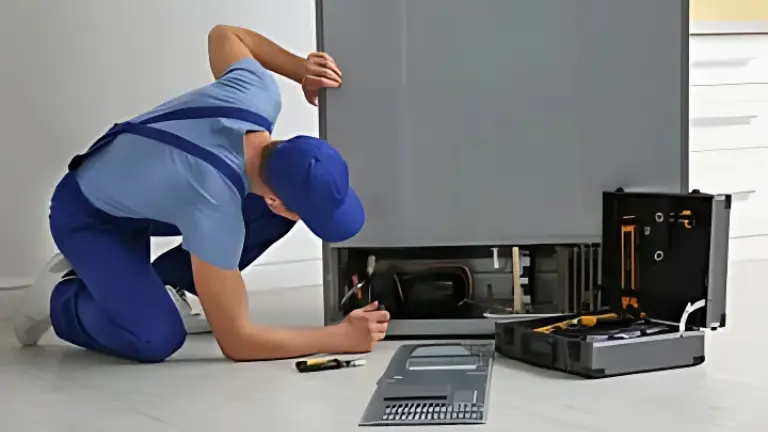Why Is My Refrigerator Not Cooling? Common Causes & Solutions

Refrigerators are central properly in modern daily life, helping us store perishable foods, maintain fresh produce, and keep drinks perfectly chilled. Yet, over time, even top-quality fridges can fall victim to cooling issues—ranging from temperature fluctuations to more severe mechanical breakdowns. These problems can lead to spoiled meals, wasted groceries, and frustration for entire households if left unaddressedEvaporator. In this blog, we’ll explore the common reasons behind a refrigerator not cooling properly, detail practical fixes you can attempt, and show when professional help is your best course of action for lasting results.

Overview of How Refrigerators Work
Refrigerators rely on a power-driven refrigeration cycle—managed by coils, a compressor, and a sealed system filled with refrigerant. When working properly, the refrigerator compartment maintains consistent cold air, while the freezer compartment keeps items solidly frozen. At the core is the compressor, which compresses refrigerant vapors, directing heat away from the interior. With evaporator coils inside and condenser coils outside, the fridge can discharge heat while retaining a cool temperature.
- Thermostats and temperature controls help maintain desired coldness.
- Evaporator fan circulates air across chilled coils, ensuring your produce and other goods remain at stable temperature.
- Proper airflow and a secure door seal keep air inside, preventing excessive condensation or leaks that hamper efficient cooling.
Each of these components must operate harmoniously to ensure your freezer compartment and fresh-food section maintain consistent temperatures.
Signs Your Refrigerator Is Not Cooling Properly
Before a full-blown malfunction arises, your fridge may display subtle clues that it’s not operating at the correct internal temperature. Catching these red flags early can prevent major inconveniences.
1. Temperature Fluctuations
If the fridge cycles between too warm and too cold, certain items might freeze in the fridge while your freezer partially thaws. This signals potential issues with the thermostat, the temperature controls, or possibly the fridge’s control board.
2. Excessive Frost Build-up
A modern refrigerator with an auto-defrost feature shouldn’t accumulate thick frost. Heavy ice layers on freezer walls or the evaporator coils commonly indicate a blocked defrost timer or heater, restricting normal defrost cycles.

3. Unusual Noises
Persistent buzzing, knocking, or rattling typically means the compressor or evaporator fan is struggling. Some mild humming is normal, but new or loud noises suggest urgent attention.
Common Causes of Cooling Issues
Your fridge’s lack of cooling may come from multiple factors. Below are key reasons behind these common appliance issues:
1. Incorrect Thermostat Settings
Sometimes, a simple oversight like turning the temperature dial too low or high might explain poor cooling. Misaligned or broken temperature controls can lead to a refrigerator temperature that’s not ideal for storing food.
2. Blocked Air Vents
When air vents are obstructed by groceries or containers, airflow inside compartments diminishes, preventing consistent cold distribution. This scenario often reveals itself through uneven temperatures or partial freezing in unexpected spots.
3. Dirty Condenser Coils
Condenser coils at the back or beneath your fridge help expel heat. Caked in dirt, pet hair, or dust bunnies, these coils struggle to dissipate warmth, making the refrigerator overwork and hamper efficient cooling. A simple brush or vacuum can solve the issue.
4. Faulty Door Seals
Worn, dirty seals or a damaged gasket around the door allow cold air to leak out, forcing the fridge to run overtime. This leads to higher energy bills and variable temperatures within compartments.
5. Low Refrigerant Levels
A lack of refrigerant (due to small leaks or natural depletion) undercuts cooling capacity. The compressor can’t compress enough vapors for adequate cold temperature circulation, resulting in a fridge that struggles to maintain a consistent chill.
6. Malfunctioning Compressor
A failing compressor or faulty compressor relay drastically undermines your fridge’s performance. Your device’s motor might start but fail to pump refrigerant vapors effectively, evidenced by a silent compressor or constant clicking sounds.
7. Broken Evaporator Fan
When the evaporator fan malfunctions or jammed evaporator coils occur, cold air doesn’t circulate well inside your fridge. Food near the back might freeze, while items up front remain warm.

Practical Solutions for Cooling Problems
1. Adjusting Thermostat Settings
Sometimes, a quick fix involves verifying your temperature settings. If your fridge is accidentally on a warmer setting than intended, turn the dial or press digital controls until it’s at the proper temperature (generally 37-40°F in the fridge, 0°F in the freezer).
2. Cleaning Condenser Coils
Using a coil brush or vacuum, remove dust, debris, and pet hair from the condenser coils every few months. This simple step drastically boosts cooling efficiency by allowing heat to dissipate.
3. Unblocking Vents
Ensure freezer or fridge vents remain clear of items stacked near them. Move bulky containers or large leftover boxes away from airflow paths so cold air can circulate thoroughly.
4. Inspecting and Replacing Door Seals
Check if gasket seals are cracked, dirty, or no longer snug. Cleaning them with a damp cloth and mild detergent might solve a small problem. If they’re heavily worn, opting for a new gasket keeps cold air inside, extending your fridge’s life.
5. Checking Refrigerant Levels
If your fridge’s cooling remains subpar after simpler fixes, a licensed technician can measure and restore your fridge’s refrigerant charge. This advanced solution ensures the system has the correct fluid volume to sustain the optimal performance.
6. Testing the Compressor
For persistent cooling issues, have appliance repair specialists test the compressor and replace it if needed. While not always cheap, a new or fully functional compressor is essential for maintaining a stable internal climate.
When to Call a Professional
Certain problems, like recurring power outages, persistent strange noises, or water infiltration around electrical parts, warrant immediate expert intervention. If repeated DIY attempts fail or you encounterlack of improvement, professional help is the best route to save time and money. Licensed appliance repair technicians ensure a thorough diagnosis of hidden parts—like defrost timer or control boards—and guarantee your fridge meets safety standards.
Handling Advanced Refrigerator Problems
Some people may encounter less typical common issues that aren’t covered by standard troubleshooting steps. Below, we outline more sophisticated scenarios and the corrective action often needed to secure a viable solution:
- Power Cord and Power Supply Concerns
A damaged power cord or unstable power supply can lead to erratic fridge performance or complete failure. In such cases, you might spot intermittent shutoffs or failing digital freezer temp buttons. Before taking your refrigerator in for repair service, check if the cord is firmly connected or if the circuit breaker has tripped. In many instances, performing these basic checks can answer minor usage questions without diving into more extensive repairs. - Complex Ice Maker Challenges
Modern fridges come with advanced ice maker programs and functionalities, stored in a program in memory within the appliance’s control board. When these computerized processes glitch, you may see random ice dumping, excess frost, or partial freezing in the freezer doors. While online videos can provide quick insights, complexities like software bugs, condenser fan misbehavior, or a faulty refrigerator compressor often demand professional evaluation. An extended warranty service provider can be invaluable here, especially for owners concerned about major replacements or potential issues reappearing. - Influence of External Factors
Many millions of people place their refrigerators near windows or in direct sunlight. Continuous exposure to direct sunlight elevates ambient temperature, forcing the fridge to work harder and risking premature part failure. Relocating the fridge away from a bright area or shading it from harsh rays can serve as a beneficial corrective action.
Similarly, storing the fridge in a less-than-ideal “natural habitat” (like a garage without climate control) can drive up operational costs and reduce the fridge’s overall life. - Programming and Setting Adjustments
Modern fridges have a “program” controlling everything from the freezer’s defrost cycle to temperature readouts. A disrupted “program in memory” can skew the unit’s calibration, leading to inconsistent cooling or inefficient operation. Sometimes, toggling the Freezer temp buttons or reinitializing the device can fix the error, but more serious malfunctions warrant a licensed appliance repair team’s expertise.
Why Professional Help is Key
Because these advanced issues can involve delicate electronics, incorrectly addressing them can cause further damage or void warranties. Relying on a professional keeps your fridge safe, safeguarding your investment while preventing a minor glitch from escalating into a costly breakdown.
Whether you’re facing a complicated code within the fridge’s computer or dealing with a misaligned compressor in the presence of direct sunlight, calling in Toronto Refrigeration is often the most effective solution. Our expert technicians are trained to handle intricate repairs with specialized tools and thorough knowledge—reducing guesswork and ensuring prompt results.
How Can Toronto Refrigeration Help?
Since inception, Toronto Refrigeration has devoted itself to delivering quality and reliable service across the GTA. From standard fridge maintenance to advanced, emergency repair, we handle a wide range of brands and models. Our experienced staff come equipped with specialized tools and knowledge to fix temperature irregularities, handle major mechanical breakdowns, and conduct routine check-ups. We also extend our services to Stove Repair, washer or Dryer Repair, freezer repair, and more—forming a one-stop solution for any of your appliance needs. When you need swift, thorough help, trust our combination of competitive or adequate prices, prompt appointments, and unwavering dedication to your convenience.
Preventive Maintenance Tips for an Efficient Refrigerator
Preventive maintenance ensures your fridge remains consistent, energy-efficient, and free from major issues:
1. Regular Cleaning
Keep the interior free from old food residue or spilled liquids to avoid mold or bacteria buildup. Wiping the shelves and door bins with mild detergent helps maintain a sanitary environment.
2. Monitoring Temperature Settings
Stay vigilant about any unexpected changes in the freezer or fridge compartments. If the internal temperature wavers drastically, quickly investigate or consult an Appliance Repair Etobicoke professional before the problem escalates.
3. Scheduling Routine Check-ups
Having a licensed technician evaluate your unit on a set schedule—once or twice a year—lets them identify early signs of malfunction, preventing large-scale breakdowns. This step is especially crucial for older models or high-use units in bigger households.
Conclusion
Refrigerators lie at the center of our kitchens—preserving fresh produce, storing tasty leftovers, and chilling beverages year-round. But once cooling issues strike, ignoring them leads to higher cost and potential food spoilage. By applying straightforward fixes—like cleaning condenser coils or removing blockages from vents—you can often restore the cool temperature your family needs. For bigger concerns—such as a faulty compressor or persistent temperature inconsistency—seeking professional help ensures proper repairs and a longer life for your fridge. Don’t wait for problems to escalate; maintain your refrigerator today for a reliable, worry-free kitchen routine.